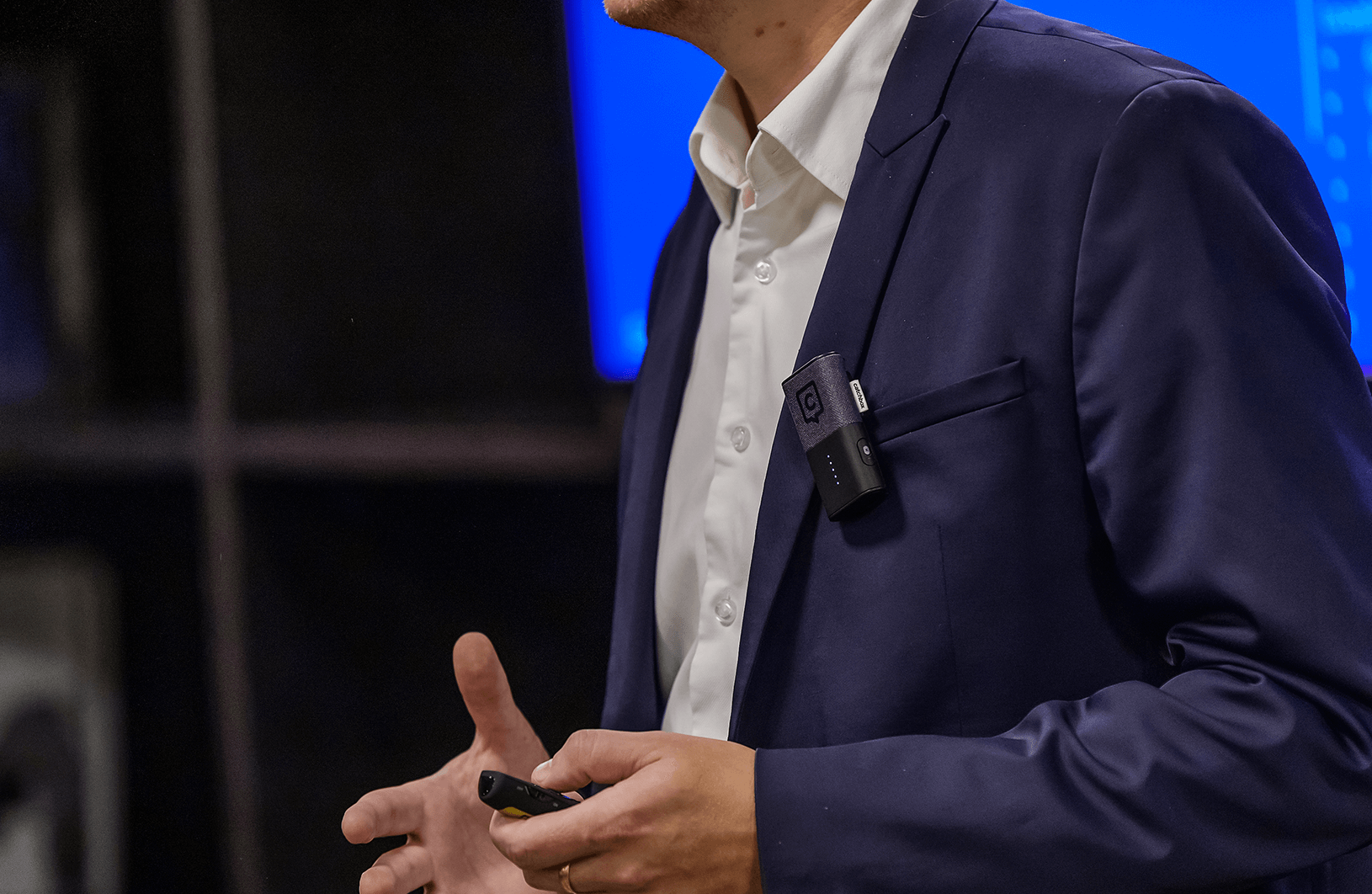Please use a microphone: why even 'loud' voices benefit from microphones

Published on: May 9, 2024
There's a common vice among public speakers, be it presenters, lecturers, or anyone else that frequents the stage or podium to address an audience – they often make it a point of pride to reject a microphone.
“I have a loud voice”, “I don't like the sound of my voice over speakers”, “I've been doing this for years, the audience will hear me fine”, and other classic excuses have had audio technicians rolling their eyes for years. Not for any personal reasons, but because, by forgoing a microphone, there's a serious risk of the audience being on the receiving end of a subpar audio experience.
Indeed, countless students, professors, and event attendees have expressed frustration at the presenter's choice to skip a microphone even though one is available. There's even a veritable list of reformed public speakers who look back at their prideful years with horror. And everyone's rallying around a single message:
Please use a microphone.
In this article, we'll detail why you should always say “yes” to a microphone from three perspectives: the technical, the audience's, and the speaker's; as well as address the common fear of the microphone and share how to dispel it.
1. Technical: There's a reason why the mic's there
For many presenters, having their voice fill up a room is not just a natural ability, it's a skill that has been honed over the years and one speakers are keen to make use of. A loud and clear presenting voice IS something to be proud of.
However, volume isn't the only factor determining how well the audience hears you. The space's acoustics, background noise, seating arrangements, and other things significantly impact how far and how clearly your voice carries. While your voice may command a classroom, that doesn't necessarily translate to a different venue.

Tackling these challenges is the field of expertise of audio technicians – not presenters. The audio setup of a venue is typically fine-tuned to the benefit of the audience based on abundant experience with previous events. So when a production assistant or AV engineer offers you a microphone, understand that it's not a suggestion, but a professional recommendation.
That said, even if you aren't offered a microphone, there's good cause to ask for one anyway.
2. Audience: You don't always know who you're talking to
The woman in the front row on the edge of her seat – is she really, REALLY into your presentation or is she simply straining to hear you because of her hearing difficulties and you forgoing a microphone?
Microphones are grand levelers when it comes to accessibility. For one, they amplify your voice, helping those with hearing impairments capture every word. Notably, it's not just about volume. Some people struggle with filtering sounds when there's competing noise like, for example, at a conference, where the murmur of networking right outside the stage room and people constantly shuffling about can distract even the most attentive listener.
As one lecturer put it: “Refusing to use a microphone is like scheduling a meeting in a room accessible only by stairs”.
Nowadays, when a lot of events – and even lectures – are being either live-streamed or recorded, crisp audio capture is critical for live captioning or translation, which may confer key benefits for accessibility and better comprehension. Without a microphone grows the likelihood of audio distortion and, hence, text being corrupted by background noise, echos, and software misinterpretation.
This is a particularly common issue for lecture capture, where lecturers comfortable with their space tend to avoid microphones. While in-person students may be fine with it, this scenario can pose challenges to others joining remotely or rewatching recordings at a later date.

3. Speaker: It's not just about talking loudly
A loud voice paired with confidence only gets you halfway.
A common reason for rejecting a microphone is wanting to sound more natural and appear relatable. However, by raising their voice, presenters often inadvertently achieve the opposite – they sound more strict and aggressive, undermining any effort at creating a connection with the audience.
Moreover, sustaining a high volume for a prolonged length of time requires a significant amount of focus, energy, and self-awareness. It's common to see presentations start off explosively, only to conclude in a monotone droning, leaving the audience to wonder if it's still the same presenter.
Of course, all of this assumes that you ARE speaking loudly. People taking their first steps in public speaking often underestimate just how much they need to put into their voice to reach the back of the room – to you, it might sound like you're shouting, yet people in the back might struggle to make out what's being said.
Juggling all of these considerations, while delivering a clear and engaging talk is an exceptional ability. And even then, it's one that's enhanced by the addition of a microphone.
This addition can also improve your well-being as a speaker. Voice fatigue – often characterized by feelings of a dry mouth, a lump in the throat, and/or shortness of breath – is an occupational hazard among public speakers, and lecturers in particular.
During Catchbox client visits in higher education institutions, we have repeatedly heard that voice fatigue has been a driving factor behind the adoption of microphones in lecture halls, as leading multiple classes a day strains the voice causing discomfort – it takes effort to speak and maintain volume. By reducing the strain placed on vocal cords, microphones help abate voice fatigue.

Beyond pride: Overcoming the fear of the microphone
Of course, not all hesitation to pick up a mic stems from hubris. For some, doubt is instilled by negative experiences with technical hiccups. For others who gesticulate a lot, there are worries of microphones limiting their range of movement. Others yet simply can't get over the sound of their voice over speakers.
To that last point, there are no two ways about it – it's a personal challenge that must be overcome. As a public speaker, you cannot place your own comfort above the audience's ability to understand you.
However, technical worries can be easily remedied with a suitable and modern audio setup. That's why the Catchbox Clip has become a hot favorite among higher education institutions, event venues, and even individual speakers who opt to travel with it.
“As an event moderator, I found the Catchbox Clip microphone particularly convenient compared to traditional headsets or handheld microphones. Connecting it to the conference room audio system was seamless, and the sound quality was excellent. We would like to use Catchbox microphones for our future conferences” – Evita Legzdina, Marketing Manager, eazyBI.
The Catchbox Clip lavalier microphone is the perfect user-friendly solution thanks to its compact, convenient, and wireless design. It easily clips onto your shirt (no bulky beltpacks and wires) or you can wear it with a lanyard, making it ideal for those whose clothing doesn't allow direct microphone attachment, like dresses or delicate fabrics.
For a complete whole-room audio setup that invites the audience into the discussion, the Catchbox Plus system is the perfect solution, as, alongside the Catchbox Clip, it features a wireless audience microphone and a Hub that connects everything seamlessly together.
Respect your audience, use a microphone
The PROs of using a microphone outweigh the CONs so severely that picking one up is a no-brainer. In fact, the only CON is a lack of faith in the technology, and, with Catchbox, that one can be crossed out, too.
Get in touch to learn more about how Catchbox can help you and your presenters bury the fear of the microphone once and for all.
Recommended
Find out more

Significance of live captions
Captions have become more important than ever, not just for accessibility in an increasingly digital world, but for productivity and quality of life, too. Explore what is live captioning, how it works, and why more people are using it.

Catchbox for events
Make sure your event leaves a lasting impression. Intuitive, fun and easy to use, Catchbox mics encourage increased audience engagement by facilitating dynamic discussions and quickfire Q&A sessions.